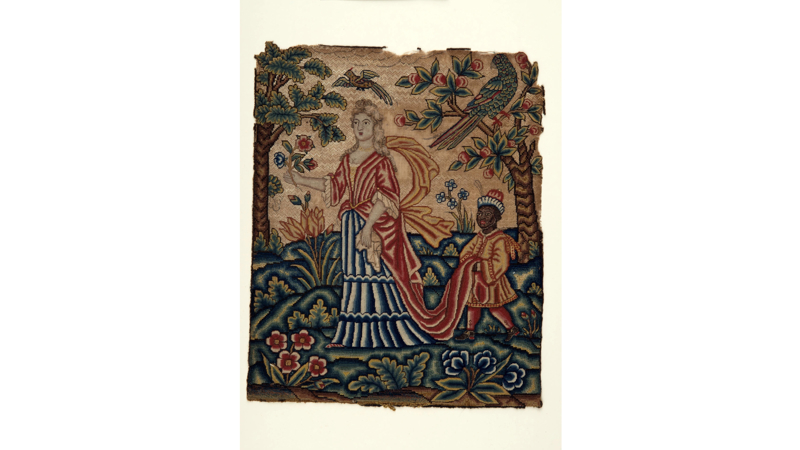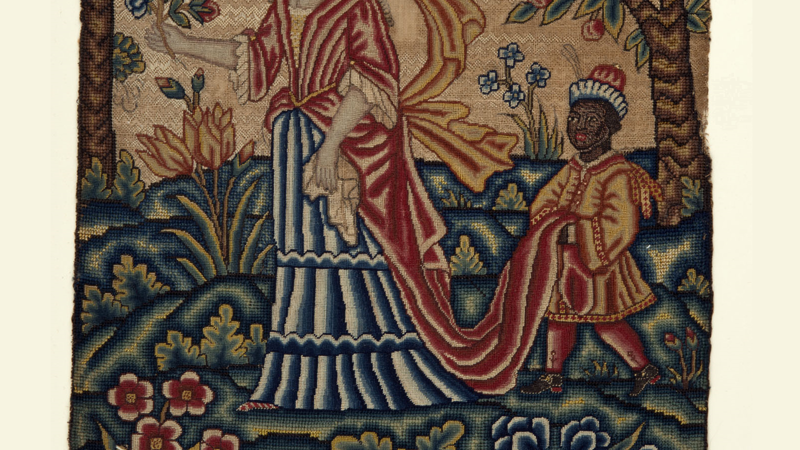A fashionable accessory?

Embroidered panel
About 1700-1715, made in Britain
Glasgow Museums, Burrell Collection 29.92
Images © CSG CIC Glasgow Museums Collection
14th August 2018
What at first appears to be a charming piece of needlework actually reflects one of the darker sides of British history. This panel is made from linen embroidered in coloured silk and wool threads with cross, flame, satin and tent stitches – all relatively simple techniques suggesting that it was made by an amateur as a leisurely pastime. Against a fantastical background of flowering plants, fruit trees and exotic birds stands a well-dressed fair-skinned lady wearing the fashions of the early 1700s. The trailing skirt of her red mantua or dress is draped up and pinned behind her to form a long train that is carried by her page – an enslaved African boy in a smart yellow uniform with red hat and stockings.
Whilst the vast majority of peoples trafficked by slave traders ended up working on plantations in America, the Caribbean and Africa, a small proportion of young African and Asian boys and girls were brought back to Britain by slave traders, merchants and high-ranking naval officers specifically to become domestic servants. Samuel Pepys’ diary entry for 30 May 1662 records his visit to Sir Edward Mountagu, 1st Earl of Sandwich’s flagship, the Royall James, where he ‘saw a little Turke and a negro, which are entended for pages to the two young ladies. Many birds and other pretty noveltys there was.’
These young slaves were not hidden below stairs, but openly waited in attendance on their owners acting as pages, maids and grooms – adding a dash of exoticism alongside the imported birds. They appear in the fore- or back-ground of many middle- and upper-class portraits acting as foils or status symbols. One page offers a basket of birds in Circle of Gilbert Jackson, Portrait of a Lady (said to be Florence Smyth) with Her Black Page, about 1640 (The Red Lodge Museum, Bristol) – the Smyths were a wealthy merchant family from Bristol – while two hold the blue velvet robes of estate in Peter Angelis, Queen Anne and the Knights of the Garter, about 1715 (National Portrait Gallery, London). In both examples the boys are immaculately dressed in white linen and silk doublets. Interestingly, like the page in the embroidery, none of them wear the silver collars depicted in so many other paintings as a clear visual statement that the boys are slaves rather than salaried servants.

Detail: Embroidered panel
About 1700-1715
Glasgow Museums, Burrell Collection 29.92
As if the elaborate liveries these enslaved children wore was not a sufficiently conspicuous display of a family’s wealth, one of their many tasks was to serve the products of the slave economy – tea, coffee and sugary dainties. Another was to carry the trailing luxurious silk gowns as seen in this panel. Young black enslaved pages appear as train-bearers not only in contemporary portraits of queens and duchesses, but also in an early fashion print showing Nicholas Bonnart, Recueil des modes de la cour de France ‘Dame de la Cour’, about 1678–93 (The Los Angeles County Museum of Art). It is as if a black page was merely the latest accessory a fashionable lady should have.
Rebecca Quinton
Research Manager (Art)
Related images
Supposed Portrait of Florence Smyth (b.1634), and an Unnamed Black Attendant
